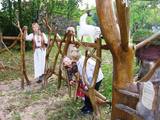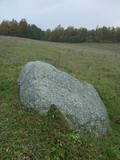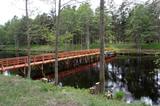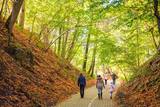| Nr | Nosaukums | Apraksts |
|---|---|---|
|
Neliela apdzīvota vieta Daugavas krastos starp Aizkraukli un Jaunjelgavu. Skrīveru apkaime saistās ar populārā latviešu rakstnieka A. Upīša gaitām un darbiem. Netālu no Skrīveriem meklējams arī vecākais Latvijas dendrārijs. Tā izveidi 1891. g. uzsācis Skrīveru muižas īpašnieks Maksimilians fon Siverss. Parka dendroloģiskajā klāstā ir ap 400 augu sugu, šķirņu un formu. Viens no lieliskākajiem Daugavas skatiem pavērsies no t.s. Kraukļu kalniem – stāva Daugavas labā pamatkrasta augšdaļas, kas ir sens pilskalns. |
||
|
Teritorijas apskates nolūkos ir izveidota un labiekārtota dabas izziņas taka. Dabas liegums atrodas Abavas senlejas dabas parka teritorijā. Taka iepazīstina ar vienīgo krūmu čužas savvaļas augšanas vietu Latvijā. |
||
|
Meža večas ģimenes parks izveidojies starp Kaikas kupolveidīgajiem pauguriem, un sastāv no vairākām viensētām, kas piedāvā uzzināt par dabai tuvu, veselīgu dzīvesveidu un tautas medicīnu. Katrai viensētai ir sagatavota sava programma, kur apmeklētāji var iepazīties ar ārstniecības augiem, ārstēšanu ar dēlēm, bišu un sēņu noslēpumaino pasauli, izjust buramvārdu un meditāciju vietu ietekmi uz sevi. Te māca gatavot ēdienus no nezālēm, cept maizi un taisīt garšaugu maisījumus. Ar viensētām var iepazīties arī individuālie apmeklētāji. |
||
|
Dabas parks ir izveidots Ziemeļkursas augstienes Vanemas pauguraines izteiktākās un ainaviskākās daļas – Talsu pauguraines aizsardzībai. Šis ir viens no ainavas ziņā skaistākajiem Kurzemes apvidiem, kur nelieli, bet izteikti pauguri mijas ar starppauguru ieplakām, kurās izvietojušies mazi, bet samērā dziļi ezeriņi – Ābeļu ezers, Čumals, Sirdsezers u.c., no kuriem daži atgādina dziļus krāterus. Teritorija piemērota aktīvā tūrismam – pārgājieniem, velobraucieniem u.c. |
||
|
Izbraucot no Kolkas Melnsila virzienā, pa ceļam var piestāt pie Zēņu dīķa. Tā ir 1,3 ha liela mākslīga ūdenskrātuve, ko 20.gs. 60.gados izraka, lai iegūtu ledu Kolkas zivju fabrikas vajadzībām. Makšķerēšana un pastaigas. Apsaimnieko biedrība “Kolkas makšķernieku klubs”. |
||
|
Užavas alus darītavā, 20 km no Ventspils, tiek ražotas trīs alus šķirnes - Užavas GAIŠAIS, Užavas TUMŠAIS un Užavas ZIEMEĻU alus. Piedāvā grupu ekskursijas ar stāstu par šīs vietas vēsturi un alus darināšanas procesu. Blakus esošajā veikalā var iegādāties dažādu šķirņu alu un ar alu saistītus suvenīrus. |
||
|
Žiļu ģimenes saimniecību izveidoja, uztur un par to rūpējas viena ģimene. Ziņkārīgie atpūtnieki pastaigas laikā var redzēt, kā izskatās baltie pāvi, fazāni, pīles, vistas, poniji, „Šarolē” šķirnes franču liellopi, Lietuvas baltās genofonda cūkas. |
||
|
"Līdumkalni" atrodas Ķurbē -Kurzemes ziemeļrietumu daļā, starp Dundagas mežiem un Ķurbes lielo silu, zaļu pakalnu vidū, 15 km no jūras un ne pārāk tālu no debesīm. Šeit laiks rit lēni. Tas nevienu nesteidzina. Laika pietiek, lai vērotu Dieva radīto pasauli un ieskatītos Viņa bagātajā aptiekā. Laika pietiek lai iepazītos ar kristīgajām tradīcijām un dzīvesveidu, lai iegūtu praktisku lūgšanu un meditāciju pieredzi. Laika pietiks arī veselīgas maltītes pagatavošanai lauku virtuvē vai uz ugunskura un pašam savas gleznas uzgleznošanai gleznotājas darbnīcā. |
||
|
Ja jums patīk aktīvs dzīvesveids, šī ekskursija ir ideāls veids, kā izbaudīt kulināro mantojumu, kas slēpjas Gaujas Nacionālajā parkā. Velomaršruts sākas no Strenčiem un vispirms ved caur divām vietējām alus darītavām Brenguļos un Valmiermuižā ar jaukām kafejnīcām un labu alu. Ceļā uz Valmieru apstāsieties arī Trikātas ciematā, lai nobaudītu vietēji gatavoto šokolādi. No Valmieras maršruts ved cauri skaistam mežam uz Cēsīm un tur esošo burvīgo viduslaiku vecpilsētu. Cēsīs apmeklēsiet vietējo maiznīcu un spirta rūpnīcu, lai nobaudītu produkciju. Jūs redzēsiet arī to, kā viduslaikos izskatījās ārstniecības un garšaugu dārzs. Brauksiet ar kanoe no Cēsīm uz Līgatni, kas ir viena no Gaujas skaistākajām vietām ar tās smilšakmens krastiem, attālām lauku viensētām un vecmodīgu ūdensdarbināmu prāmi. Līgatnes pilsētas vēsturiskais centrs ir saistīts ar tās papīrfabrikas attīstību. Šeit iespējams apmeklēt arī vietējos vīna un rokdarbu ražotājus vienā no apgabalam raksturīgajām mākslīgajām alām. Pārvietojoties pa kalnainajiem, līkumotajiem Siguldas ceļiem, redzēsiet Turaidas un Siguldas viduslaiku pilis, Gūtmaņala alu un citus gleznainus skatus. Siguldā baudīsiet latviešu tradicionālos ēdienus restorānos “Bucefāls”, “Aparjods” un viesu namā “Mauriņi” nobaudīsiet 80 ievārījumu veidus. |
||
|
Reta galda vīnogu kolekcija un degustācija, ainaviska dārza apskate un stāstījums par ķirbjaugu, čilli un tomātu šķirņu kolekciju. Kolekcijā ir 120 šķirņu tomātu, 20 šķirņu paprikas un aso piparu, 140 šķirņu ķirbjaugu. Degustācijas galds - sukādes, čilli, interesanti ievārījumi un pašu fermentētas tējas. |
||
|
Tagadējais dievnams (iepriekšējie celti 1652. un 1776. g.) būvēts laikā no 1839. - 1842. g. Vidzemē pazīstamā lībiešu būvmeistara Mārča Sāruma (1799. –1859.) vadībā. Par prototipu tam izmantoja Pievolgas vācu koloniju baznīcu veidolu. Dievnama altārī atrodas Pītera Paula Rubensa gleznas “Kristus pie krusta” kopija (oriģināls – Minhenē), ko 1887. g. baznīcai uzdāvināja Nēķena muižas īpašniece. Baznīcas remonta laikā (1928. g.) atklāja piemiņas plāksnes 1. pasaules karā un Latvijas Brīvības cīņās kritušajiem. Blakus baznīcas atrodas viduslaiku kapsēta. Celtnes autors un būvdarbu virsuzraugs - H. fon Hagemeistars esot teicis, ka šis dievnams esot „vienīgā baznīca visā Vidzemē un varbūt arī pasaulē, kas uzcelta bez apreibināšanās”. |
||
|
Pastaigājoties pa kilometru garo zemes ceļu, kas omulīgi stiepjas gar jūru, var sajust īsto ciema burvību. Labajā pusē skatu bagātina jūrā izmētātie akmeņi, miniatūri puķu dārziņi jūras krastā, aicinoši soliņi, apgāztas laivas. Krasta pusē jau vairāk kā gadsimtu stāv tagadējā Kaltenes bibliotēka. 1899. g. celta kā Nogales barona Nolkena vasarnīca – vairākkārt pārbūvēta un mainījusi savu lomu sabiedrībā. Sākotnēji no 1926. g. šeit atradusies pamatskola, pēc tam klubs, bet no 1992. gada - atkal sākumskola. Ejot pa ceļu, aplūkojamas sakoptas, skaistas kurzemnieku piejūras sētas, starp kurām var atrast arī tādas veco zvejnieku un kuģu būvētāju dzimtas mājas, kā Burliņi. Pie Žulnieku valka „Smilgās” atradusies kuģa kalēja Pētera Valdemāra smēde, kurš bijis tā laika galvenais kuģu kalējs posmā no Kaltenes līdz Upesgrīvai. (Avots: Rojas TIC) |
||
|
38 m augstais Ovišu bākas mūra tornis (signāluguns - 33 m augstumā) celts 1814. g. un bez ievērojamām izmaiņām darbojas arī mūsdienās. Šī ir mūsu valsts vecākā funkcionējošā bāka. |
||
|
Saimnieki audzē šitaki sēnes un piedāvā ekskursiju ar stāstījumu par sēņu audzēšanu un to labajām īpašībām. Sēņu iegāde, konsultācijas. Piedāvā bioloģiskā veidā ražotu lauksaimniecības produkciju, medu. |
||
|
Lielstraupes pils ir vienīgā Latvijā saglabājusies celtne, kur vienā ēkā ir apvienota viduslaiku pils un baznīca. Pils celtniecību uzsāka 1263. g. Apbūve ļoti cieta 17. un 18. gs. laikā, kā arī 1905. g. nemieru laikā. Ēku kompleksu atjaunoja 1909. g. pēc arhitekta V. Bokslafa projekta. Lielstraupes baznīcā atrodas vairāki mākslas pieminekļi - 17. gs. ērģeļu luktu un 18. gs. kanceles gleznojumi. 1944. g. dienamā uzstādīja mākslinieka S. Vidberga vitrāžas "Golgāta" un "Kristu dzimšana". Savukārt, pils tornī redzams vietējā pulksteņmeistara Aides darināts pulkstenis, bet uz baznīcas sienas - saules pulkstenis. Pils parkā ir jāaplūko 1744. g. no koka būvēto zvanu torni. 1938. g. baznīcā atklāta piemiņas plāksni 1. pasaules karā un Brīvības cīņās kritušajiem. No 1963. g. pilī darbojas narkoloģiskā slimnīca. Baznīca ir apskatāma dievkalpojumu laikā, bet pārējais ēku komplekss – no ārpuses. |
||
|
Progresīvā bioloģiskā saimniecība audzē ap 50 dažādus bioloģiskos dārzeņus un zaļumus. Lauksaimniekiem pieder 10 hektāri zemes, kur viņi audzē no seniem laikiem Biržu reģionā izplatītus dažādu sugu āra un siltumnīcu dārzeņus. |
||
|
Šis ir viens no retajiem ceļiem, kurš saglabājies kā notikumu liecinieks. Ceļš ved no Krimuldas uz Siguldu. Jau vācbaltu apgaismotāja novadpētnieka – mākslinieka Johana Kristofa Broces 1794. gada zīmējumā "Siguldas un Krimuldas pilsdrupas" redzams lauku ceļš gar Krimuldas pili, pa kuru iet zemnieks un darba ratus velk zirgs. Lai braukšana pa Gaujas senlejas nogāzi ar zirga pajūgu būtu droša, ceļu izveidoja līkloča formā, tā uzbrauktuvi padarot daudz lēzenāku. Domājams, ka ceļš atjaunots 19 gs., kad Krievijas cars Aleksandrs otrais un viņa sieva ieradušies uz vizīti siguldā. Pāri ceļam bijuši vairāki mazi tiltiņi, ko iedzīvotāji dēvējuši par velna tiltiem. Tagad serpentīna ceļš kļuvis par romantisku pastaigu vietu. |
||
|
Atrodas ziemeļrietumos (jūras virzienā) no Pitraga baptistu baznīcas. Kurgati ir zvejnieka un zemkopja saimniecība, kas celta pagājušā gadsimta trīsdesmitajos gados, ienesot lībiešu apdzīvotajā piekrastē jaunus būvelementus – nošķeltu jumta galu, kas nebija raksturīgs lībiešu ciemu ēkām. |
||
|
Lubāna ezers, Lubāna mitraine. Lubāns – platības ziņā lielākais
ezers (80,7 km2) Latvijā, vislielākais iedambētais ezers Eiropā, un ap
to esošais Lubāna mitrājs bioloģiskās daudzveidības ziņā ir unikāla
vieta ne tikai Latvijā, bet arī starptautiskā mērogā – dabas liegums,
iekļauts Eiropas Savienības aizsargājamo teritoriju tīklā NATURA 2000
un atbilstoši Ramsāres konvencijas kritērijiem – starptautiskas nozīmes
mitrājs. Lubāna mitrājs, ko vietējie iedzīvotāji jau izsenis dēvē par
klāniem, ir zemie un augstie purvi, slapjās pļavas, mitrie meži.
Rudeņos un pavasaros ūdenskrātuvēs apmetas tūkstošiem migrējošu
ūdensputnu, kurus ērti novērot no putnu novērošanas torņiem vai ūdenstūrisma attīstības centra terases.
|
||
|
Sigita un Kārlis Smiltiņi ir latviešu tradicionālo vērtību sargātāji. 2010. gadā, dzimstot idejai par rudzu maizes cepšanu, abi salabojuši veco laiku maizes krāsni, kuru nu jau izmanto ceturtā paaudze, lai latviešiem tik ļoti svētītais darbs - maizes cepšana neietu zudībā. Smiltiņu mājās - Ventspilī, viesiem ir iespēja aplūkot rudzu maizes un auzu karašas cepšanas procesu. Apmeklējums iepriekš jāpiesaka, vienlaikus saimnieki var uzņemt ne vairāk kā 5 cilvēkus! |
||



























